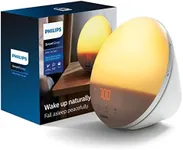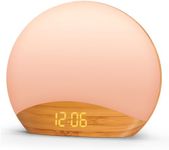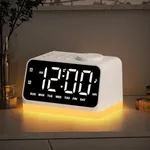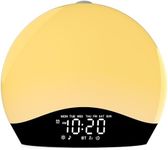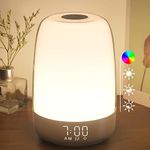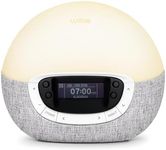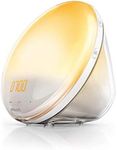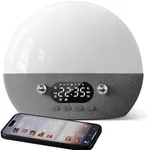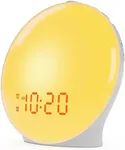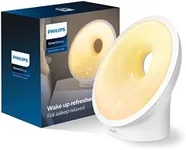Buying Guide for the Best Wake Lights
Wake lights, also known as sunrise alarm clocks, are designed to help you wake up more naturally by simulating a sunrise. They gradually increase the light intensity to gently wake you up, which can be less jarring than a traditional alarm clock. When choosing a wake light, it's important to consider several key specifications to ensure you select the best one for your needs. Here are the main specs to look at and how to evaluate them.Light IntensityLight intensity, measured in lux, determines how bright the wake light can get. This is important because a higher intensity can more effectively simulate natural sunlight, which can help you wake up more easily. Wake lights typically range from 100 to 300 lux. If you are sensitive to light or prefer a gentle wake-up, a lower intensity might be sufficient. However, if you have trouble waking up or your room is very dark, a higher intensity might be more effective.
Light ColorThe color of the light can affect how natural the wake-up experience feels. Many wake lights offer a range of colors, from warm reds and oranges to cooler whites and blues. Warmer colors are generally more soothing and can mimic a natural sunrise more closely, which can be beneficial for a gentle wake-up. Cooler colors can be more stimulating and might be better if you need a more energetic start to your day. Consider your personal preference and how you respond to different light colors when making your choice.
Sound OptionsIn addition to light, many wake lights offer sound options to help wake you up. These can include nature sounds, white noise, or even FM radio. The type of sound can influence how pleasant your wake-up experience is. If you find nature sounds relaxing, look for a wake light that offers a variety of these sounds. If you prefer waking up to music or the radio, ensure the wake light has these features. Think about what sounds help you wake up feeling refreshed and choose accordingly.
Sunset SimulationSome wake lights also offer a sunset simulation feature, which gradually dims the light to help you fall asleep. This can be beneficial if you have trouble winding down at night. The duration and intensity of the sunset simulation can vary, so consider how long it typically takes you to fall asleep and choose a wake light that matches your needs. If you often struggle with falling asleep, a wake light with a good sunset simulation feature might be particularly helpful.
Alarm CustomizationThe ability to customize your alarm settings can make a wake light more versatile and better suited to your routine. This can include setting multiple alarms, adjusting the duration of the sunrise simulation, and choosing different sounds for different days. If you have a varied schedule or share the wake light with someone else, look for one with flexible alarm customization options. This will allow you to tailor the wake light to fit your specific needs and preferences.
Ease of UseA wake light should be easy to set up and use, especially if you are not very tech-savvy. Look for a wake light with intuitive controls and a clear display. Some wake lights also come with smartphone apps that allow you to control the settings remotely, which can be convenient. Consider how comfortable you are with technology and choose a wake light that matches your level of comfort. A user-friendly wake light will ensure you can easily take advantage of all its features.
Size and DesignThe size and design of the wake light can affect how well it fits into your bedroom decor and how much space it takes up on your nightstand. Wake lights come in various shapes and sizes, from compact models to larger ones with more features. Consider the available space in your bedroom and your aesthetic preferences when choosing a wake light. A well-designed wake light that complements your room can enhance your overall experience and make it a pleasant addition to your morning routine.

